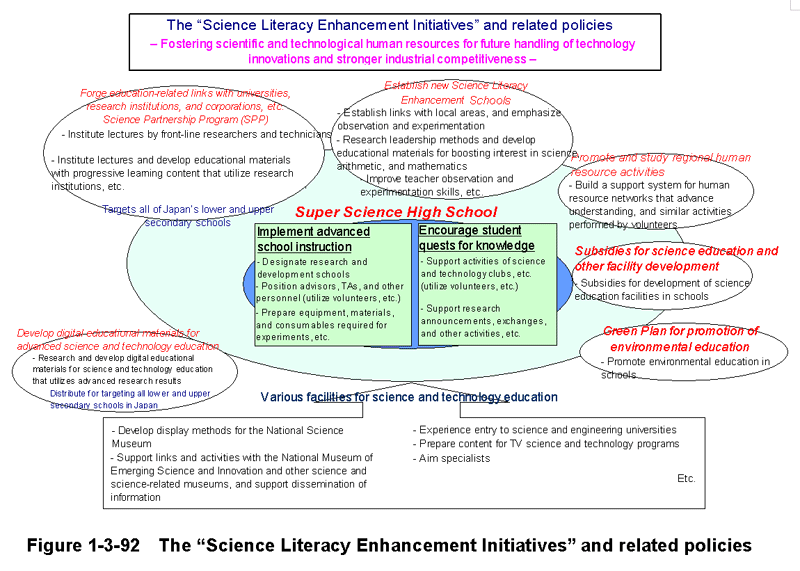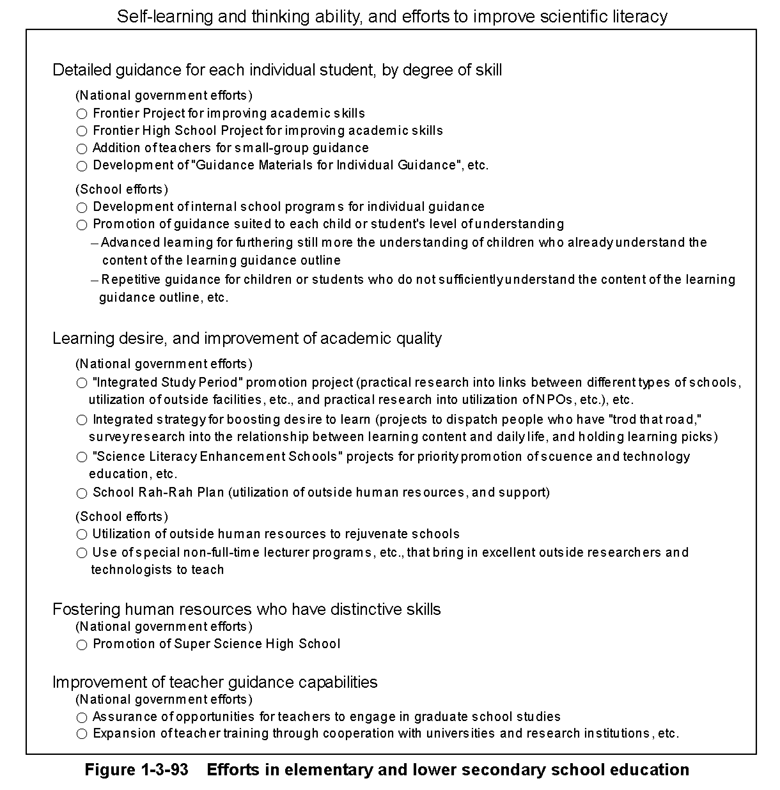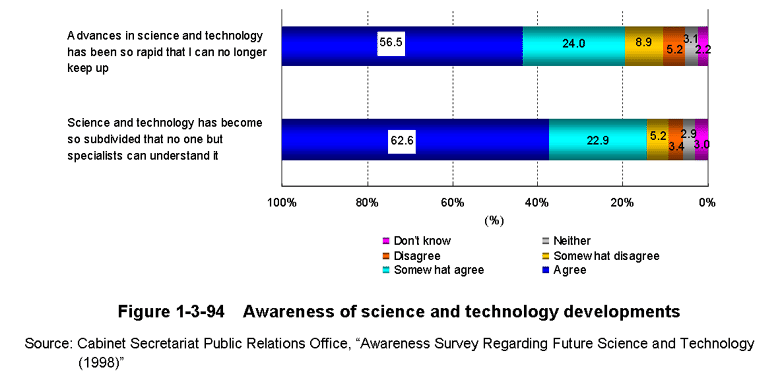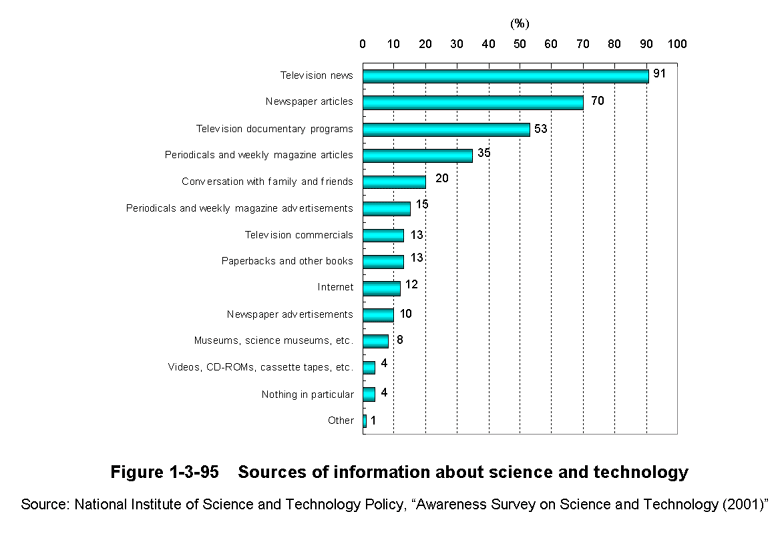| Home > Policy > White Paper, Notice, Announcement > White Paper > WHITE PAPER ON SCIENCE AND TECHNOLOGY2003 > Part1 1.3 1.3.3 1.3.3.2 | ||
In order to create a society that develop HRSTs,it is important to foster human resources who can undertake careers related to in the future science and technology and,even more,to foster ordinary citizens with interest in and understanding for science and technology.Various efforts are need-ed at every level of education,from elementary and lower-secondary school education to life-long learning,to link science and technology with ordinary citizens.
| (Various Efforts in Elementary and Lower-Secondary School Education) |
The role of elementary and lower-secondary school education is extremely important for the development of excellent HRSTs,in particular,re-search personnel rich in creativity.In this case,what is needed is not mere one-way transmission of knowledge,but rather an education that encourages creativity while laying the foundation for the fundamentals and the basics of science and technology.
Elementary and lower-secondary school educa-tion is not just the teaching of basic knowledge and skills.It is also a time for ensuring"academic ability,"which involves the desire to learn,and the abilities to learning,think by oneself,make better decisions,and acquire not merely knowledge but the ability abilities for logical thinking that takes the principles of things into consideration even after completion of education.For this purpose,active utilization of various new education programs that give children intellectual curiosity and possession of an active learning stance will help students extend their creativity even after completion of their elementary and lower-secondary school education,and can be expected to assure a supply of promising future HRSTs.
| (1)Reinforcing"Academic Ability" |
The new Cources of Study released in April2002for all of Japan's elementary and lower-secondary schools aims to encourage child-ren's"Zest for living,"introduces"Period for Integrated Study"that performs experiential and problem-solving learning to foster such"academic ability"as learning and thinking by oneself,and expands the range of elective courses.
The"Period for Integrated Study"aims to help students to foster self-learning,thinking,and analysis skills through experiments,observation,and other experiential and problem-solving learning.These activities can be expected to encourage children to think about science and technology on their own,and to foster attitudes conducive to creative and intellectual activities.It is expected that implementation of the Period for Integrated Study will lead to accumulation of practical experiences that can be shared and utilized among schools.
For students who demonstrate excellent skills in science and mathematics it is important to expand their skills by individualized teaching,such as to engage them in progressive learning suited to their individual levels of understanding and skill.For this purpose,schools in the future can be expected to promote teaching that encourages learning by skill level and grade skipping programs,so as to actively extend superior skills and foster top-class human resources.
At the same time,giving additional lessons and other detailed guidance to students who have an insufficient understanding of the contents standardized by the cources of study is essential so that they can firmly acquire the fundamentals and basics,and deepen their grounding in science and technology.
| (2)Development of Teachers in Charge of Education in Science |
Among researchers who are currently active,some report being they have influenced by teachers while in elementary or lower-secondary school.Teachers who can use experiments and other methods,to demonstrate how interesting science can be,during elementary and lower-secondary school when children have the most curiosity,are priceless assets.It is expected that people with such skills can be actively utilized as teachers,and it is required to provide various kinds of training to teachers who have the closest relationships to students,so that they can identify and understand science's significance and transmit that understanding to students.
The Education Personnel Certification Law was amended in May2002,adopting measures for a more flexible teacher certification system that will expand expert guidance programs by allowing lower and upper-secondary school teachers to teach science,mathematics,and other subjects at elementary schools,alongside music and other already existing technical courses.Moreover,regardless of whether they have a teaching certification or not,people will be allowed to apply to the prefectural board of education to teach certain sections of courses,through the"Part-time Teachers without Teachers Certificates Program"(a program for skilled researchers or technicians to function as school teachers and course assistants),and it is expected to strengthen children's basic understanding of science and technology.At the same time,to raise the expert capabilities of teachers,development of training institutes at science museums and other museums is important,as is utilization of Leave for Graduate School Study System that allow teachers to study at graduate schools while pursuing their careers,so that they can engage in specialized,systematic studies in various specialist fields at the graduate school Master's degree level,and obtain specialist certifications required for more advanced qualifications and skills.
| (3)"Science Literacy Enhancement Initiatives" |
The Ministry of Education,Culture,Sports,Science and Technology adopted the"Science Literacy Enhancement Initiatives"in FY2002,to implement comprehensive policies for the sup-port and promotion of efforts in science and tech-nology education.The main content of this plan is as follows.
![]() Designate schools that place priority on science,technology,and
mathematics education as"Super Science High Schools,"and re-search
and develop policies for education courses placing priority on science and mathematics
and for effective cooperation with universities and research institutions,etc.
Designate schools that place priority on science,technology,and
mathematics education as"Super Science High Schools,"and re-search
and develop policies for education courses placing priority on science and mathematics
and for effective cooperation with universities and research institutions,etc.
![]() Support"researcher invitation lectures"that invite
researchers and technicians to lecture at schools through cooperation between
education units and universities,research institutions,private-sector enterprises,or
others,"cooperative education lectures"where students are given opportunities
to experience and learn cutting-edge science and technology at universities,research
institutions,etc.Also support"teacher training"implemented in cooperation
with prefectural boards of education and universities,research institutions,etc.,perform
surveys and research into the most suitable methods for implementing the above
programs,and publish information from researchers regarding the latest science
and technology(Science Partnership Program).
Support"researcher invitation lectures"that invite
researchers and technicians to lecture at schools through cooperation between
education units and universities,research institutions,private-sector enterprises,or
others,"cooperative education lectures"where students are given opportunities
to experience and learn cutting-edge science and technology at universities,research
institutions,etc.Also support"teacher training"implemented in cooperation
with prefectural boards of education and universities,research institutions,etc.,perform
surveys and research into the most suitable methods for implementing the above
programs,and publish information from researchers regarding the latest science
and technology(Science Partnership Program).
![]() Develop digital teaching materials that utilize results of
recent research from research institutions,etc.,in order to provide to educational
sites.
Develop digital teaching materials that utilize results of
recent research from research institutions,etc.,in order to provide to educational
sites.
With the advance of globalization,the role of English as a common international language for communication is growing in the fields of science and technology,and English language ability has become an important element for HRSTs.
In March2003,the Ministry of Education,Culture,Sports,Science and Technology adopted an action plan for fostering"Japanese with English Abilities."The action plan includes proposals to promote the"Super English High School"project,teacher training,and student exchange programs for upper-secondary school students.Reforms in English language education can be expected to play an important role for fostering future HRST.

The"Super Science High School"(SSH)concept is designated by the Ministry of Education,Culture,Sports,Science and Technology to upper-secondary schools that place priority on science,technology,and mathematics education.Twenty-six upper-secondary schools around Japan secured that designation in FY2002. The SSH schools are involved in efforts to develop S&T education,including R&D into curriculums that place priority on science and mathematics,and research into methods for effective cooperation with universities and research institutions,etc. For example,Okayama Ichinomiya Prefectural High School has independently set up a Super Science Lab course for its first grade science students,incorporating such topics as"the microscopic world,""the basics of biotechnology,"and"gene science"to foster in students basic experimental skills and experimental data processing abilities,and to prepare the way for the"topic research"course taught in the following year. Toyama Prefectural High School is cooperating with Toyama University to introduce courses in cutting-edge S&T,and in mathematics.The courses proceed according to a student's learning progress and interests,giving students a good idea of what university lectures feel like,deepening their interest in the various science themes,and providing the mental preparation for them to become researchers in the future. Kokutaiji Prefectural High School in Hiroshima prefecture used a television conferencing system to engage in two-way course instruction with researchers at National Astronomical Observatory of Japan in Hawaii.The students asked question about the Subaru Telescope,and about astronomy and volcanoes,etc.,and the lecturers responded with explanations tailored for the students'easy understanding,for an excellent course program. The program is set to continue for a three-year research period,during which various efforts and R&D suited to the circumstances at each school will be promoted,toward the goal of fostering S&T personnel who can help realize an advanced-science and technology-oriented nation. |

| (Efforts for Education in Advanced Education) |
Universities and colleges are not only institutions for fostering HRSTs,they also play a role in fostering people who can sustain an adequate recognition of the relationship between science and technology,and society.In a knowledge-based society like today's,where science and technology are becoming more advanced,and various fields are becoming fused together,it is desirable not only to cultivate knowledge that bridges the gap between science and culture,but also to foster human resources who can maintain an understanding of science and technology,and who have the rich cultivation suitable for indipendent judgment of relationships with science and tech-nology from the viewpoint of the people.
In the Central Education Council's February2002report,"On General Education in the New Era,"universities are strongly required to rebuild their general education,and proposals are presented to improve curriculums and guidance methods,to develop frameworks for active promotion of university and teacher efforts,and to establish responsible programs for implementation of general education.
| (Promotion of Lifelong Learning) |
In order improve grounding in science and technology,it is important to provide opportunities for learning in science and technology in elementary and lower-secondary school education,in advanced education,and throughout people's adult lives.In particular,providing opportunities for lifelong education to the parents of children,particularly to mothers who have the closest contact with young children,is important for fostering HRSTs in the future.For this purpose,expansion of learning opportunities during societal education and other occasions helps to maintain the knowledge standards of HRST and to cultivate new HRSTs.
| (The Importance of Interpreters) |
It is a common problem that children have difficulty recognizing the relationship between science and technology and life in society,and many adults have feel as if they can no longer keep up with scientific and technological advances in recent years. (Figure1-3-94) In other words,it has become extremely difficult for ordinary people to acquire knowledge about increasingly complex and advanced science and technology without help of some kind.In addition,resolving the social issues that have appeared alongside recent advances in science and technology will require formation of a foundation for communication between science and technology,and society.In this situation,the role of the"interpreter"is increasing in importance,as a bridge between expert researchers and technicians,and the non-expert general population.The role of interpreter can be played by the mass media,science museums and other museums,curators of those museums,and educators about science.In addition,NPO(non-profit organization)and other local community efforts are also expected.
| (1)Mass Media |
Many people,regardless of age,relying on television,newspapers,and other mass media for their science and technology information so that the mass media plays a huge role as an interpreter (Figure1-3-95) .
Because science journalism can sway the people's interest,understanding,and evaluation of science and technology,the stance of the mass media may have a huge influence on society at large.Furthermore,science and technology norms presented by the mass media are often accepted by the people as national norms.
At the International Conference of Science and Technology Journalists,held in Tokyo in2001,it was noted that journalists also need to have a deep insight of science and technology,alongside that of researchers and technicians.It is then noted that no program for fostering such journalists exists in Japan,which is a problem from the point of view of sound education in science and technology.
Science journalism needs cultivation and evaluation of personnel capable of correctly and appropriately communicating information from researchers and technicians to the adult population,and also to the children as well.


| (2)Science Museums,Etc. |
Science museums collect,store,and display materials related to the natural sciences and other sciences,and these materials are provided to educate the general public.In the past,museums have mainly served as places of learning for young people.Now curators and other museum staffers are expected to utilize their expertise and special positions to serve as interpreters targeting a broad spectrum of the population.
A shortage of curators and other interpreters has become a problem in recent years,however.In response,efforts are being made to establish the status of curators and to increase their numbers,and to promote the recruitment of volunteers and cooperation from local communities for activities that promote understanding of science and technology to foster future interpreters.
Museums and similar facilities should be at the center of local activities regarding promotion of understanding about science and technology,bringing together the potentials of researchers,technicians,and other experts,and volunteers from the general population,to effectively cultivate interest and understanding of science and technology in people of all ages,and particularly in young people,and to bring out their educational role by promoting links with schools,such as through provision of training opportunities for teachers.
| (3)Non-Profit Organizations(NPOs)Engaged in Activities Related to Science and Technology |
In recent years,spontaneous activities by ordinary citizens to contribute to society have increased,and the position of NPOs has increased in importance as a new actor for public interests.NPO activities are mainly run by volunteers,and because people who agree with the philosophy behind their activities spontaneously come together,and they can concentrate on activities related to their goals,NPOs are known for their high degree of member mobilization and for high degrees of awareness among their members.Furthermore,unlike the government,they are capable of providing detailed services tailored to individual needs.
In activities promoting understanding of science and technology,NPOs are also expected to play a significant role.Such NPO activities can foster interpreters and increase opportunities for participant exchanges in science and technology,and can help build environments to further deepen local people's understanding of and interest in science and technology,strengthen links and activate information exchanges between citizen groups,and help ordinary citizens make independent judgments about social issues involving science and technology.
While one problem regarding NPO activities has been their weak organizational foundation,the Law to Promote Specified Nonprofit Activities(NPO Law)that was amended in December2002(and implemented in May2003)added"activities to promote science and technology"to the list of possible NPO activities,and development of an environment facilitating NPO activities related to science and technology is now in progress.In the future,NPO activities will need to proceed in cooperation with governments,through evaluations at the citizen level,and they are expected to expand their activities.
| (4)Various Activities Engaged in the Spread of Science and Technology |
Other interpreters for promoting interest and understanding of science and technology to generate more familiarity among the general population,particularly among young people,are as listed below.
![]() TV and radio Programs on Science and Technology
TV and radio Programs on Science and Technology
Television programs such as the"Children's Broadcasting Station,"which featured the"Science Channel"and"el-Net"(Education Information Satellite Communications Network),offer easy-to-understand introductions to science and technology to a wide audience,and provide opportunities for coming into contact with information.
![]() Provision of Information over Internet
Provision of Information over Internet
Another method for transmitting information to a large audience has now appeared.The Internet offers faster communication speeds and more connection servers creating an environment for people to acquire information with ease at home,at school,and elsewhere.
Internet information is not limited to the mass media,with researchers,technicians,and other interested individuals stepping forward as interpreters to provide various information,and greatly expanding the people's opportunities for coming into contact with scientific and technological information.
![]() Organization of Various Science and Technology Events
Organization of Various Science and Technology Events
Many events provide opportunities for promoting interest in and understanding of science and technology among the public,especially among young people.Such events,like robot contests and the"Science Fair for Youths,"are designed to pique interest in science and technology.Clubs,such as the Japan Institute of Invention and Innovation's"Boys and Girls Invention Club"as well as camps like the"Science Camp"run by the Japan Science Foundation,also aim to pique interest in science and technology by allowing participants to experience creating things firsthand.Various public entities and private-sector enterprises play an important social role in actively promoting these activities for the public good.
| Back to Top | MEXT HOME |